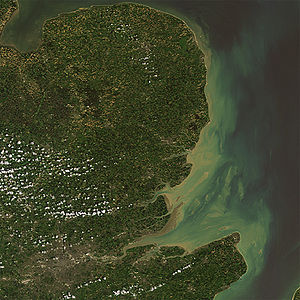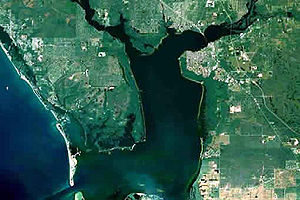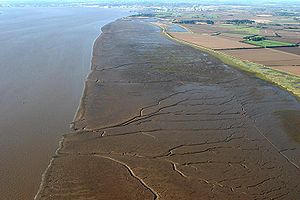Comparative bacterial composition of estuaries
Estuaries
- Certain types of bacteria are able to recycle nutrients in specific conditions, such as the denitrification process under anaerobic conditions. This process converts nitrates, which may be in problematic concentrations due to sewage inputs, into inert nitrogen gas. Other types potentially reduce sulphur and carbon dioxide levels in the water. All these processes lead to reducing the harmful substances in the water so that wildlife may flourish. Estuaries are normally very productive, providing habitats and nutrients for a large number of organisms [1]. This is largely due to the interaction of freshwater and saline water flowing in and out of the estuary. Any substances that make its way into the estuary are not easily removed; they are ingested by organisms and magnified within the food chain. By analyzing the bacterial composition in estuaries, one can follow the chemical reactions occurring in the waters. This way, one can potentially revert polluted estuaries to their original productive state, recovering fisheries and the likes.
Estuarine waters generally contain more heterotrophic activity compared to saltwater and freshwater waters. [2]
Crude oil is a complex mix of hydrocarbons. It is naturally occurring in the waters, but because of the extensive uses of oil in human activities, oil inputs in water are more likely to increase with time, causing harm to surrounding aquatic life. Fortunately, nature provides certain microbial communities that aid in eliminating some of the hydrocarbons. In estuarine sediments, Bacillus spp. are the main players of carbon degradation; in the water column, Rhodococcus, Gammaproteobacteriaand Micrococcus are some main genera[1].
Thames Estuary
- Thames Estuary is located on the coast of Great Britain, Europe. It serves as a major shipping route, providing leeway for oil tankers and ships of other substances. Because of this, rare occasions of oil spills occur, threatening biolife in the vicinity. It is characterized with high tides, thus bringing in a large amount of nutrients rapidly. A study with experimental oil spillage showed that the oil induced rapid growth and increase of Gammaproteobacteria, Thalassolituus oleivorans, Cycloclasticus spp, and Alcanivorax borkumensis [1]. Oelispira antartica has been noted to only increase at 4°C[1], suggesting that this species is subject to temperature changes.
- There were studies indicating high levels of anaerobic activity due to the anoxic environment, mainly involving nitrogen such as denitrification. Though the specific bacteria remain unknown, Nitrosomonas eutropha, a well-known denitrifier, were shown to be able to proliferate in Thames waters.[3]
Charlotte Harbor Estuary
- Harbor Estuary is a subtropical, well-mixed, shallow body of water created by the convergence of Myakka and Peace Rivers in the North, and Gulf of Mexico in the West.[4] It is naturally occurring in Florida, and is the second largest open water estuary in the state. It has an area of about 13 000 km2. Because of its high productivity, increases in human populations lead to increases in commercial fishing and land development, which ultimately lead to polluted waters.[5] Like many other polluted waters, the tides give off a red/brown hue, indicating high turbidity.
- Poor sewage treatments are often one of the main sources of non-point pollution; increased run-offs lead to increased inputs of nutrients and microbial pathogens.[4] In a study by Lipp et al., Cryptosporidium, and Giardia spp., protozoan pathogens which were common human fecal indicators, were found to be abundant. That suggests that there were also increases in concentrations of fecal coliforms - facultative anaerobic, Gram negative bacteria. They usually indicate that the waters contain high fecal matter, which can be from human sewage, pulp and paper mill effluent, or agricultural run-offs.[6] They found that concentrations were highest in August, and from December through February, they concluded that these species were subject to seasonal variations.[4] Also, they found that areas with higher freshwater input and low salinity are correlated with high levels of the indicator species.[4] In addition, concentrations of C. perfringens are generally higher in sediments relative to the water column, consistent with the study done by Ferguson et al. on an Australian estuary.[7]
Humber Estuary
- Located in Northeastern England, this estuary originates from Rivers Ouse and Trent[8], has an area of about 300 km2 and connects to North Sea. It has a freshwater flow of 2.1x107 m2 per day[9], and an average seawater flow of 1.4x109 m2 during the spring and neap tides. Due to the discharge of industrial wastes and untreated sewage directly into the water, the once productive estuary is now highly polluted [10]. High amounts of suspended solids are naturally added from eroding coasts; and the added suspended solids from the pollution encourage growth of attached bacteria. In fact, most of the bacteria in that body of water are attached. However, oxygen levels are tolerable because of dilution and strong turbidity, giving it a brown appearance[11]
- Also due to increased human colonization, oxygen levels are beginning to decline as a result of high nutrient input due to anthropogenic pollution, triggering growth of nitrogen-degrading bacteria such as Nitrosomonas spp, as mentioned earlier.
References
- ↑ 1.0 1.1 1.2 1.3 Greer (2010). "Bacterial Diversity in Hydrocarbon-Polluted Rivers, Estuaries and Sediments". Biomedical and Life Sciences. Springer Berlin Heidelberg . ISBN 978-3-540-77587-4. http://www.springerlink.com/content/r671448483tq2kx6/fulltext.html. Retrieved 2010-04-06.
- ↑ Wright, R.T. and Coffin, R.B. 1983. Planktonic bacteria in estuaries and coastal waters of northern Massachusetts: spatial and temporal distribution. Mar. Ecol. Prog. Ser. 11: 205-216.
- ↑ Trimmer, M. Nicholls, J.C., Deflandre, B. 2003. Anaerobic Ammonium Oxidation Measured in Sediments along the Thames Estuary, United Kingdon. Applied and Environmental Microbiology 69(11):6447-6454.
- ↑ 4.0 4.1 4.2 4.3 Lipp, E.K., Kurz, R., Vincent, R., Rodriguez-Palacios, C., Farrah, S.R., Rose, J.B. 2001. The Effects of Seasonal Variability and Weather on Microbial Fecal Pollution and Enteric Pathogens in a Subtropical Estuary. Estuaries 24(2):266-276.
- ↑ Charlotte Harbor Preserve State Park http://www.floridastateparks.org/charlotteharbor/. Retrieved April 13, 2010.
- ↑ Doyle, M. P., and M. C. Erickson. 2006. Closing the door on the fecal coliform assay. Microbe 1:162-163
- ↑ Ferguson, C.M., Coote, B.G., Ashbolt, N.J., and Stevenson, I.M. 1996. Relationships between indicators, pathogens and water quality in an estuarine system. Water Research 30:2045-2054.
- ↑ Goulder, R., Blanchard, A.S., Sanderson, P.L., and Wright, B. 1980. Relationships Between Heterotrophic Bacteria and Pollution in an Industrialized Estuary. Water Research 14:591-601.
- ↑ Denman,N.E.: Physical characters of the Humber. In: The Humber Estuary. University of Hull/ Humber Advisory Group Joint Symposium (N. V. Jones, ed.). Hull : Department of Zoology, University of Hull 1973
- ↑ Bent, E.J. and Goulder, R. 1981. Planktonic Bacteria in the Humber Estuary; Seasonal Variation in Population Density and Heterotrophic Activity. Marine Biology 62: 35-45.
- ↑ http://www.riverhumber.com


